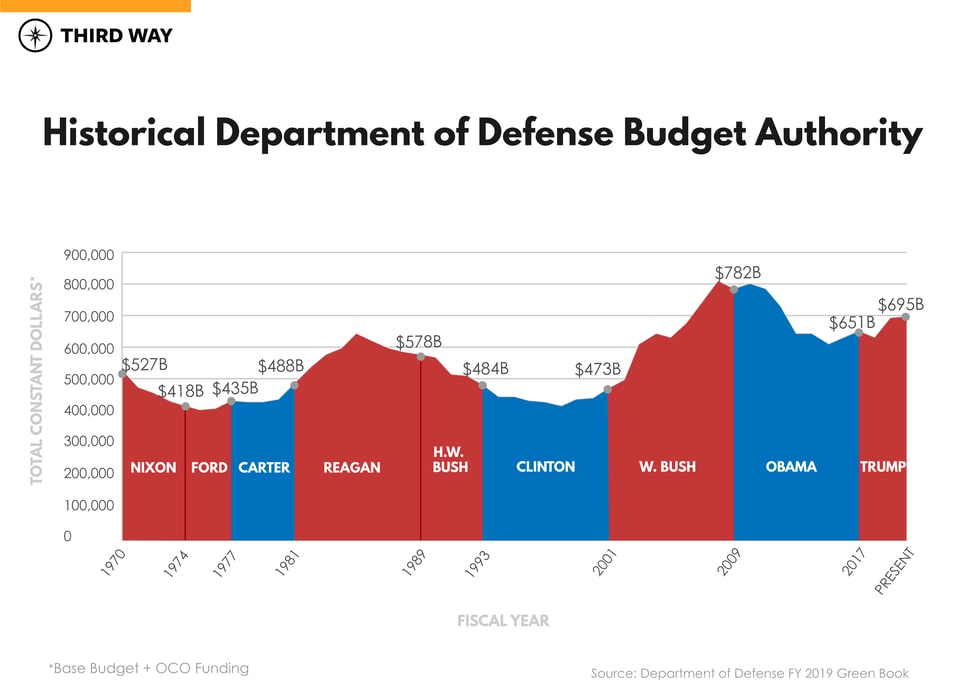Primer Published March 7, 2019 · 12 minute read
Thematic Brief: The Department of Defense Budget and Oversight
The National Security Program

Takeaways
Despite the president’s contradictory criticism and support for the size of the US Department of Defense (DoD) budget, the Administration has continued to request substantial increases in funding for DoD. In addition, President Trump has pushed for ineffective and wasteful missions, such as the creation of a US Space Force and symbolic deployment of active duty troops to the US-Mexico border.
Members of Congress must strengthen their oversight over DoD activities and advocate for a defense budget that promotes strong US national security. In order to do this, congressional Democrats must take action to:
- Reduce President Trump’s reported Fiscal Year (FY) 2020 Defense Budget of $750 billion in line with his stated intent to withdraw troops from Syria and Afghanistan;
- Repeal or add a sunset clause to the 2001 Authorization for the Use of Military Force (AUMF) and consider a new, narrowly tailored AUMF for US counterterrorism efforts; and
- Reject the president’s symbolic, wasteful military proposals, including holding military parades, deploying active duty troops to the US-Mexico border, threatening a state of emergency, and creating a Space Force—all of which distract from military readiness.
The military needs to align its budget with its need. If President Trump wants to reduce US military forces overseas, the DoD budget needs to reflect such a scaling back.
The Trump Administration is reportedly requesting a surge in defense spending for FY 2020. This dramatic increase in defense spending is contradictory to the president’s stated call for the withdrawal of US troops from Syria and Afghanistan. If the United States is scaling back these large-scale military operations overseas, then the defense budget should be reduced to align with these withdrawals.
If requested, President Trump’s reported FY 2020 defense budget would be the largest since the height of the Iraq war,1 even though the president has said he intends to withdraw troops from a number of global conflicts. While the president has yet to officially submit the FY 2020 budget to Congress, it has been reported that he will seek $750 billion in military spending for that year alone.2 In 2011, the United States was spending close to $805 billion (adjusted for inflation) on defense, but as US troops were withdrawn from Iraq by President Obama the military budget was cut in recognition of this scaling back.3 Now, the Trump Administration is seeking an exorbitant increase in defense spending while simultaneously withdrawing from US military operations abroad.

While the United States needs a strong, agile, and modern military to fight the rapidly changing threats against the country, the president’s enormous DoD budget request raises critical questions. Most importantly, the question of what this increased funding will be used for given President Trump’s spontaneous decision to withdraw all US military forces from Syria4 and his stated desire to end US military operations in Afghanistan.5 US troops have been engaged in the Syrian civil war since 2015, largely advising and assisting the Kurdish-led Syrian Democratic Forces who have been on the frontlines in the fight against the Islamic State in Iraq and Syria (ISIS). While President Trump has claimed that ISIS is “defeated,” the United Nations (UN), DoD, and others estimate the group still has tens of thousands of fighters in Syria and Iraq.6 While there is a strong argument to be made as to whether US forces should have been in Syria without congressional authorization to begin with, withdrawing US troops from Syria now—without a clear strategy for how to maintain security gains—may leave a vacuum that allows ISIS to regroup and emboldens Syrian President Bashar al-Assad and his supporters, Russia and Iran. Additionally, the Administration is reportedly considering a withdrawal of US troops from Afghanistan without a clear exit strategy. All of these decisions come despite protests from US military and diplomatic officials and without any clear strategy for what comes next.7
With the withdrawal of US troops from Syria and possibly Afghanistan, congressional Democrats need to question during the budget process and during possible nomination hearings for a new Secretary of Defense why DoD requires an exorbitant increase in funds. Importantly, with the withdrawal of US troops from these two key battlefields, Congress should also evaluate whether America’s diplomats and development entities have the needed funding to continue their vital work in these countries, which will be required to stabilize these countries and prevent them from returning to a safe haven for terrorists. In particular, during these processes, Congress must question:
- What is the exit strategy for Syria and Afghanistan, and how will withdrawal of a US military presence in these countries impact US national security?
- Why is a large increase in defense spending required if US troops are withdrawing from these conflicts, and can this money be better spent?
It is unclear what the final budget number will be when the Trump Administration submits the FY 2020 DoD budget to Congress. Unsurprisingly, President Trump has behaved erratically when it comes to the defense budget. In October, President Trump asked all cabinet agencies, including DoD, to draw plans to cut their budgets by 5%.8 Trump later excluded DoD from the spending cuts but directed the department to request $700 billion for FY 2020 instead of the $733 billion that it was originally seeking.9 In December, Trump publicly called defense spending levels “crazy,” but now reportedly intends to request a $750 billion budget next year from Congress.10
All of this demonstrates President Trump’s reckless decision making when it comes to the defense budget and the use of America’s military. If US troops are indeed withdrawn from Syria and Afghanistan, Congress must now support a reduction in defense spending that is complementary to this scaling back.
Congressional Democrats should repeal or add a sunset clause to the 2001 AUMF and, if necessary, consider a new, narrowly tailored authorization bill for US counterterrorism efforts.
As the Administration ends the war in Afghanistan, Congress should repeal or add a sunset clause to the 2001 AUMF and, if necessary, consider a narrowly tailored AUMF to deal with the remaining terrorist threats to the nation. Right now, Congress has very little ability to constrain the president’s ability to use military force around the globe because it has not passed a new AUMF since 2001.11
After the tragic attacks on 9/11, Congress authorized the president to use force against the people who initiated those attacks: Al Qaeda and its associated forces. Since 2014, presidents have claimed that the 2001 AUMF also allows them to fight ISIS, even though the group was not involved in the 2001 attacks but does threaten the United States. Most congressional members have never had to vote on an AUMF, despite the changing nature of the threats. Several members proposed legislation in the 115th Congress to define the president’s authorities.12 Debating a new AUMF would reassert Congress’s constitutional authority over matters of war, limiting the potential for unilateral action and unintentional escalation caused by the president, and encourage the series of checks and balances on presidential military authority intended by the Founding Fathers.13
Debate over a new AUMF on counterterrorism could help to clarify the remaining terrorist threats and explain where these threats are located. It could also illuminate how to deal with threats while avoiding mission creep and excessive US entanglement in a potential quagmire.14 For example, should the Pentagon continue its presence in Africa to advise and assist in counterterrorism operations, which is currently operating with little oversight and on questionable authority? The scale of US involvement in the region was brought to the public forefront after the deaths of four US soldiers in Niger last year.15 Congress should use the new session as an opportunity to reassert its authority over where the executive branch is conducting military operations and the target for these efforts.
Congressional Democrats should reject the president’s symbolic, wasteful military proposals, including holding military parades, deploying active duty troops to the US-Mexico border, threatening to declare a state of emergency, and creating a Space Force—all of which distract from military readiness.
Congress should reject President Trump’s politicization and wasting of military resources designed to pander to his base. These stunts are distracting from efforts to improve and enhance the readiness of America’s troops to combat the real national security threats the country faces.
Under the Trump Administration, there has been unprecedented use of US military resources for political gamesmanship. For example, President Trump wanted to host a military parade in Washington after being impressed with a similar parade on a trip to France. This would have cost an estimated $92 million at a time when the president has already cost the American economy billions of dollars in a reckless trade war with China.16 Fortunately, the parade was finally cancelled due to its high price tag.17
In 2018, President Trump also sent active duty troops to the US-Mexico border as a political maneuver to stoke fears about a “caravan” of Central American migrants seeking asylum. The number of US troops at the border peaked at about 5,800,18 with reports in December indicating that 2,200 active duty troops will be recalled,19 leaving close to 3,000 troops spread across Texas, Arizona, and California.20 However, in January, the Pentagon announced a deployment of 3,750 troops to the border21 and President Trump noted in his February 2019 State of the Union address that he has ordered this additional deployment, leading to further uncertainty around how many troops will remain deployed to the border.22 Not only do asylum seekers pose zero known threat to the United States, but use of active duty troops for this operation is problematic in three ways:
- Sending troops to the border is a meaningless political stunt and a waste of precious military resources. The border is already more secure than any other time in US history, and we currently spend more on immigration enforcement than any other federal law enforcement initiative;
- As former Defense Secretary Jim Mattis made clear, the troops cannot and should not engage directly with asylum seekers, limiting their role to ferrying around Border Patrol personnel and providing intelligence support—roles that could be conducted by other US government entities; and
- This is a mission best left to law enforcement and border patrol authorities. Our military should stay focused on addressing terrorist threats, not on an ill-defined, unending policing mission for which they are not trained.23
President Trump has recently threatened to declare a state of emergency to unilaterally build a border wall, reportedly using funds from DoD.24 This is his latest use of military resources for a political stunt. It is designed to allow President Trump to circumvent Congress and use a reported $7 billion in defense funds to build an unnecessary and ineffective wall that does not serve a legitimate national security purpose.
In addition to the military parade, deployment of troops to the southern border, and threats to declare a state of emergency, President Trump is proposing the creation of a new US Space Force, with current DoD plans structuring it inside the US Air Force, similar to the US Marine Corps structured inside the US Navy.25 However, as recently as the 2019 State of the Union address, President Trump is still calling for the creation of Space Force as a sixth branch of the military.26
Organizing Space Force as a separate service branch would reportedly cost the US military up to $13 billion over five years.27 Many national security experts have highlighted that the US Air Force is already capable of handling any potential space adversaries and setting up a Space Force would waste tax dollars and stretch US military resources.28 Former Secretary of the Air Force Deborah James29 argued that its creation will “…consume a lot of time, a lot of effort and absolutely will be a distraction.”30
The creation of a completely new, independent, and unnecessary military branch is nothing more than a political stunt by the president to pander to his base. The creation of a US Space Force would require congressional authorization and appropriations approval. If the Trump Administration submits a proposal for a new US Space Force to Congress without any compelling reason offered as to why a new military branch is necessary and worth the amount of money it would cost, members should reject this proposal.
In the interim, in December, President Trump signed a memorandum re-establishing the US Space Command,31 which was mandated by Congress. This is not the same as the proposed US Space Force, rather it is reestablishing a unified combatant command that once existed and was merged into Strategic Command in 2002.32 The Space Command will oversee all US operations in space and will be staffed with personnel from existing service branches. The Senate will have authority to confirm the commander and deputy commander of this new combatant command and should use that opportunity to question the nominees on the need for an entirely new US Space Force.
Conclusion
President Trump will reportedly request a substantial increase in the FY 2020 DoD Budget while simultaneously stating he will withdraw all US troops from Syria and Afghanistan. Congress must reject this increase and work to ensure that US defense spending aligns with the actual commitments and needs of a department whose budget has already ballooned out of control. Additionally, congressional Democrats should repeal or add a sunset clause to the 2001 AUMF and consider a new, narrowly tailored AUMF for US counterterrorism efforts to constrain the president’s ability to use military force without congressional approval. This is particularly critical at a time when President Trump has continued to waste US military resources on political stunts that in no way support military readiness. Members of Congress must assert their oversight role over DoD activities and advocate for a defense budget that promotes strong US national security, prioritizes the greatest security threats, and is conscious of the growing national debt.

